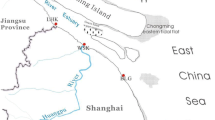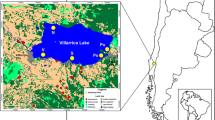Abstract
Denitrification is a major biological process to reduce nitrate to molecular nitrogen (N2). In shallow eutrophic lakes, this process can remove the largest portion of fixed nitrogen and plays an important role in self-purification of this ecosystem. To understand the structure of denitrifying communities in a shallow eutrophic lake, denitrifier communities in four sub-lakes of East Lake in Wuhan, China, were explored by restriction fragment length polymorphisms (RFLP) analysis and sequencing of nirS gene clone libraries. nirS is a functional marker gene for denitrification encoding cytochrome cd 1-containing nitrite reductase, which catalyzes the reduction of nitrite to nitric oxide. Both RFLP fingerprints clustering analysis and phylogeny analysis based on the amino acid sequences of NirS revealed that NirS-type communities in East Lake sediment could be roughly divided into three clusters. Cluster I accounted for 74–82 % of clones from the moderately eutrophic sub-lakes Tuan, Tang Ling, and Guo Zheng. Cluster II accounted for 76 % of the communities in hypertrophic sub-lake Miao Lake and cluster III as a minor group (7 % of the total), mainly presented in Miao Lake. Phylogenetic analysis revealed that cluster I was related to the reference clones from a broad range of ecological environments, and clusters II and III were more phylogenetically related to the reference clones from entrophic environments. Canonical correspondence analysis indicated that total nitrogen, total phosphate, total organic carbon, and NH4–N and NO2–N were important environmental factors affecting the dispersion of NirS-type denitrifier in the sediments. Cluster I showed a weak relationship with the nutrient content, while cluster II and III were positively related with the nutrient content. Principal coordinates analysis indicated that NirS-type communities from Tuan Lake, Tang Ling Lake, and Guo Zheng Lake sediments were divergent from those found in river, estuary sediment, and forest soil but similar to communities in constructed wetland sediment despite large geographic distances. The communities from the hypertrophic sub-lake Miao Lake deviated from other sub-lakes and the reference communities and clustered independently. Our results support the argument that environmental factors regulate the composition and distribution of the functional bacterial groups.






Similar content being viewed by others
Reference
Abell GC, Revill AT, Smith C, Bissett AP, Volkman JK, Robert SS (2010) Archaeal ammonia oxidizers and nirS-type denitrifiers dominate sediment nitrifying and denitrifying populations in a subtropical macrotidal estuary. ISME J 4:286–300
Berk BC, Ferguson SJ, Moir JW, Richardson DJ (1995) Enzyme and associated electron transport systems that catalyze the respiratory reduction of nitrogen oxides and oxyanions. Biochim Biophys Acta 1232:97–173
Braker G, Fesefeldt A, Witzel KP (1998) Development of PCR primer systems for amplification of nitrite reductase genes (nirK and nirS) to detect denitrifying bacteria in environmental samples. Appl Environ Microbiol 64:3769–3775
Brezonik PL, Lee GF (1968) Denitrification as a nitrogen sink in lake Mendota. Wis Environ Sci Tech 2:120–125
Bruesewitz DA, Hamilton DP, Schipper LA (2011) Denitrification potential in lake sediment increases across a gradient of catchment agriculture. Ecosystem 14:341–352
Castro-González M, Braker G, Farías L, Ulloa O (2005) Communities of nirS-type denitrifiers in the water column of the oxygen minimum zone in the eastern South Pacific. Environ Microbiol 7:1298–1306
Cawse PA (1967) The determination of nitrate in soil solutions by ultraviolet spectrophotometry. Analyst 92:311–315
Chen H (1989) Impact of aquaculture on the ecosystem the Donghu lake, Wuhan. Acta Hydrobiol Sin 13:359–368
Dang H, Wang C, Li J, Li T, Tian F, Jin W, Ding Y, Zhang Z (2009) Diversity and distribution of sediment nirS-encoding bacterial assemblages in response to environmental gradients in the eutrophied Jiaozhou Bay, China. Microb Ecol 58:161–169
Ettwig KF, Butler MK, Le Paslier D, Pelletier E, Mangenot S, Kuypers MM, Schreiber F, Dutilh BE, Zedelius J, de Beer D, Gloerich J, Wessels HJ, van Alen T, Luesken F, Wu ML, van de Pas-Schoonen KT, Op den Camp HJ, Janssen-Megens EM, Francoijs KJ, Stunnenberg H, Weissenbach J, Jetten MS, Strous M (2010) Nitrite-driven anaerobic methane oxidation by oxygenic bacteria. Nature 464:543–548
Focht DD, Chang AC (1975) Nitrification and denitrification processes related to waste water treatment. Adv Appl Microbiol 19:153–186
Gayle B, Boardman G, Sherrard J, Benoit R (1989) Biological denitrification of water. J Environ Eng 115:930–943
Glockner AB, Jüngst A, Zumft WG (1993) Copper-containing nitrite reductase from Pseudomonas aureofaciens is functional in a mutationally cytochrome cd 1-free background (NirS) of Pseudomonas stutzeri. Arch Microbiol 160:18–26
Goering JJ, Dugdale VA (1966) Estimates of the rates of denitrification in a subarctic lake. Limnol Oceanogr 11:113–117
Hasegawa T, Okino T (2004) Seasonal variation of denitrification rate in Lake Suwa sediment. Limnol 5:33–39
Hochstein LI, Tomlinson GA (1988) The enzymes associated with denitrification. Annu Rev Microbiol 42:231–261
Huang S, Chen C, Yang X, Wu Q, Zhang R (2011) Distribution of typical denitrifying functional genes and diversity of the nirS-encoding bacterial community related to environmental characteristics of river sediments. Biogeosciences 8:3041–3051
Jones CM, Hallin S (2010) Ecological and evolutionary factors underlying global and local assembly of denitrifier communities. ISME J 4:633–641
Kandeler E, Deiglmayr K, Tscherko D, Bru D, Philippot L (2006) Abundance of narG, nirS, nirK, and nosZ genes of denitrifying bacteria during primary successions of a glacier foreland. Appl Environ Microbiol 72:5957–5962
Katsuyama C, Kondo N, Suwa Y, Yamagishi T, Itoh M, Ohte N, Kimura H, Nagaosa K, Kato K (2008) Denitrification activity and relevant bacteria revealed by nitrite reductase gene fragments in soil of temperate mixed forest. Microbes Environ 23:337–345
Knowles R (1982) Denitrification. Microbiol Rev 46:43–70
Lozupone C, Knight R (2005) UniFrac: a new phylogenetic method for comparing microbial communities. Appl Environ Microbiol 71:8228–8235
Lozupone CA, Hamady M, Kelley ST, Knight R (2007) Quantitative and qualitative diversity measures lead to different insights into factors that structure microbial communities. Appl Environ Microbiol 73:1576–1585
Nims RW, Darbyshire JF, Saavedra JE, Christodoulou D, Hanbauer I, Cox GW, Grisham MB, Laval F, Cook JA, Krishna MC, Wink DA (1995) Colorimetric methods for the determination of nitric oxide concentration in neutral aqueous solutions. Methods 7:48–54
Plumb RH Jr. Procedures for handling and chemical analysis of sediment and water samples. Environmental Protection Agency/Crops of Engineers Technical Committee on Criteria for Dredged and Fill Material 1981, 5, AD/A103 788
Qiu D, Wu Z, Liu B, Deng J, Fu G, He F (2001) The restoration of aquatic macrophytes for improving water quality in a hypertrophic shallow lake in Hubei Province, China. Ecol Eng 18:147–156
Ruiz-Rueda O, Trias R, Garcia-Gil LJ, Bañeras L (2007) Diversity of the nitrite reductase gene nirS in the sediment of a free-water surface constructed wetland. Int Microbiol 10:253–260
Rysgaard S, Risgaard-Petersen N, Nielsen LP, Revsbech NP (1993) Nitrification and denitrification in lake and estuarine sediments measured by the 15N dilution technique and isotope pairing. Appl Environ Microbiol 59:2093–2098
Schumacher BA, Methods for the determination of total organic carbon (TOC) in soils and sediments. United States Environmental Protection Agency 2002, NCEA-C-1282
ter Braak CJF (1986) Canonical correspondence analysis: a new eigenvector method for multivariate direct gradient analysis. Ecology 67:1167–1179
Throbäck IN, Enwall K, Jarvis A, Hallin S (2004) Reassessing PCR primers targeting nirS, nirK and nosZ genes for community surveys of denitrifying bacteria with DGGE. FEMS Microbiol Ecol 49:401–417
Yentsch CS, Menzel DW (1963) A method for the determination of phytoplankton chlorophyll and phaeophytin by fluorescence. Deep-Sea Res Oceanogr Abs 10:221–231
Zumft WG (1997) Cell biology and molecular basis of denitrification. Microbiol Mol Biol Rev: MMBR 61:533–616
Acknowledgments
We are grateful to B. Zhu and X. Chen for their help in sample collection. This work was financially supported by Key Project of Chinese Ministry of Education (No. 212118) and Human Recourse Foundation of Wuhan Polytechnic University. Dr. JK Yang is an incumbent of the Chutian Scholar Program position.
Author information
Authors and Affiliations
Corresponding author
Rights and permissions
About this article
Cite this article
Yang, JK., Cheng, ZB., Li, J. et al. Community Composition of NirS-Type Denitrifier in a Shallow Eutrophic Lake. Microb Ecol 66, 796–805 (2013). https://doi.org/10.1007/s00248-013-0265-5
Received:
Accepted:
Published:
Issue Date:
DOI: https://doi.org/10.1007/s00248-013-0265-5




